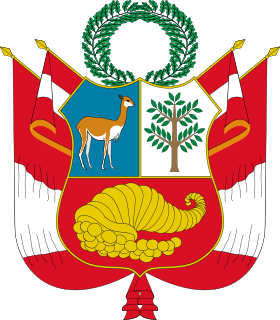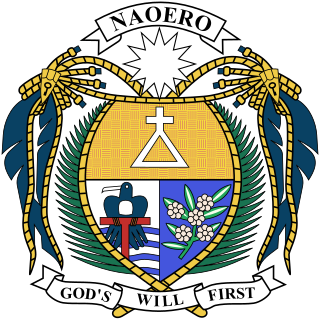
The national flag of the Republic of Moldova is a vertical triband of blue, yellow, and red, charged with the coat of arms of Moldova on the centre bar. The reverse is mirrored. The flag ratio is 1:2. Until further provisions, the State Flag of Moldova is used as the national flag and ensign as well; that is, civil, state and war flag and ensign.

The coat of arms of the Republic of Croatia consists of one main shield and five smaller shields which form a crown over the main shield. The main coat of arms is a checkerboard (chequy) that consists of 13 red and 12 white fields. It is also informally known in Croatian as šahovnica. The five smaller shields represent five different historical regions within Croatia.

The national emblem of Cape Verde contains a circle within which is written the name of the nation in Portuguese. Within the circle are a torch and triangle, symbols of freedom and national unity. At the top of the shield is a plumbob, a symbol of righteousness; three chain links are at the bottom. This emblem replaces the earlier variant with the seashell that had been in use since independence. The current emblem was adopted in 1992.

The Coat of arms of Albania is an adaptation of the Flag of Albania which is based on the flag and seal of Gjergj Kastrioti Skanderbeg. The helmet above the head of the two-headed eagle is the helmet of Skanderbeg, surmounted with billy goat's horns.

The coat of arms of Bolivia has a central cartouche surrounded by Bolivian flags, cannons, laurel branches, and has an Andean condor on top.

The national flag of Spain, as it is defined in the Constitution of 1978, consists of three horizontal stripes: red, yellow and red, the yellow stripe being twice the size of each red stripe. Traditionally, the middle stripe was defined by the more archaic term of gualda, and hence the popular name la Rojigualda (red-weld).

The Senyera is a vexillological symbol based on the Coat of arms of the Crown of Aragon, which consists of four red stripes on a yellow field. This coat of arms, often called bars of Aragon, or simply "the four bars", historically represented the King of the Crown of Aragon.

The coat of arms of Georgia is one of the national symbols of the republic. It is partially based on the medieval arms of the Georgian royal house and features Saint George, the traditional patron saint of Georgia. In addition to St. George, the original proposal included additional heraldic elements found on the royal seal, such as the seamless robe of Jesus, but this was deemed excessively religious and was not incorporated into the final version.

The current coat of arms of Venezuela was primarily approved by the Congress on April 18, 1836, undergoing small modifications through history, reaching the present version.

The coat of arms of the Russian Republic of Karelia is crossed in three equal parts with the colors of the flag of Karelia on a shield with a profile of a rampant black bear. The golden frame of the shield comes into stylized image of a fir tree on the left and a pine tree on the right. In the upper part of the shield there is an octagonal star of gold. The arms were created by Yu. S. Nivin.
Transnistria is a region in Eastern Europe that is under the effective control of the self-declared Pridnestrovian Moldavian Republic but is recognized by the international community as an administrative unit of Moldova, the Administrative-Territorial Units of the Left Bank of the Dniester. Transnistria uses a red-green-red triband and the Administrative-Territorial Units of the Left Bank of the Dniester use the flag of Moldova.

The coat of arms of Gabon was designed by the Swiss heraldist and vexillologist Louis Mühlemann, one of the founding members of the FIAV and the designer of the coat of arms of the Republic of Congo. It has been in use since 15 July 1963.

The Coat of arms of Peru is the national symbolic emblem of Peru. Four variants are used: the Coat of arms per se ; the National Coat of arms, or National Shield ; the Great Seal of the State ; and the Naval Coat of arms.

The design of the coat of arms of the Republic of Nauru originated in 1968 following the declaration of independence, and it began to be used officially in the early 1970s.

The coat of arms of Niger shows a trophy of four national flags, in the colors orange, white, and green. In the middle, the state seal is arranged. On a green or gold shield the four golden symbols are shown. In the middle, there is a sun, to the left there is a vertical spear with two crossed Tuareg swords, to the right are three pearl millet heads and underneath is the frontal view of a zebu head. Under the coat of arms, there is a ribbon bearing the name of the country in French: Republique du Niger. While the constitution of Niger stipulates the color of the symbols upon the shield, there is no uniformity on the color of the shield. The 1999 Constitution reproduces the text of earlier constitutions, making a distinction between the Seal of State for which no shield colour is stipulated and the Coat of Arms of the Republic for which Sinople is stipulated as the shield colour. Sinople is analogous to Vert (Green) in heraldry, but official buildings and documents do not display green shields. Embassies and official documents use white, with gold emblems. The website of the President of Niger uses gold or yellow with dark gold or black emblems. The National Assembly of Niger meets below a large coat of arms with the shield coloured gold and the emblems in a darker gold.

The coat of arms of the Georgian Soviet Socialist Republic was adopted on May 20, 1921 by the government of the Georgian Soviet Socialist Republic. The coat of arms is loosely based on the coat of arms of the Soviet Union. It shows symbols of agriculture. The red star rising above the Caucasus stands for the future of the Georgian nation, and the hammer and sickle for the victory of Communism and the "world-wide socialist community of states".

The emblem of the Republic of Artsakh consists of an eagle above which is an ornamented crown. On the chest of the eagle is a shield with a panorama of a mountain range and under it a vertically set Flag of Artsakh. Over this are the two stone heads of "Granny and Gramps" from the We Are Our Mountains monument in Stepanakert, the capital of Artsakh. The eagle's feet clutch various agricultural products including wheat and grapes. The outer rim is made up of a golden circular ribbon bearing inscription "Լեռնային Ղարաբաղի Հանրապետություն-Արցախ" in Armenian.

The present coat of arms of or national seal of Guinea was adopted in 1993.

This article is about the coat of arms of the German state of Rhineland-Palatinate.

The flag is the symbol of the city of Szczecin in West Pomeranian Voivodeship, Poland.



















